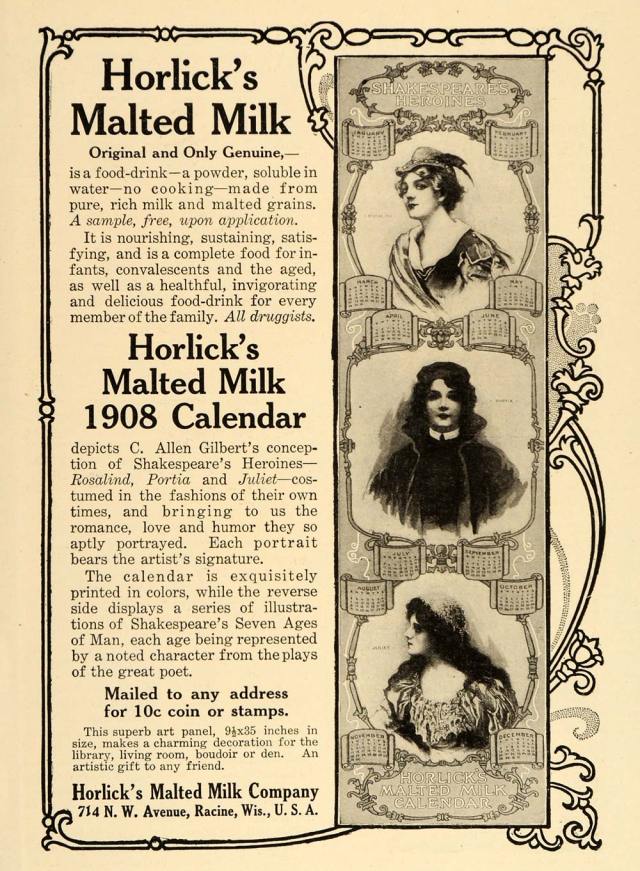The malted milkshake occupies a nostalgic but humble position in the soda fountain repertory. Most people ordering the classic malt don’t suspect that malted milk got its start as a health food, that it sustained explorers on a trip to the South Pole and soldiers in World War I, or its role as an alcohol alternative during the Prohibition.
According to the LA Times:
Technically speaking, malt is a mixture of sugars produced from starch. The thing that converts the starch is an enzyme with the silly-sounding name gibberellin, which is secreted by grain as it sprouts. Eventually the enzyme action is stopped by roasting the malt, which also caramelizes some of the sugars and produces attractive toasted flavors.
Mostly malt is fermented and turned into beer or whiskey. However, malt sugars are easy to digest, and 19th Century doctors often prescribed malt for children and invalids. There were problems with it, though. In liquid form it tended to ferment, and for years every attempt to produce a stable dried form of malt failed.
The man who succeeded in making malt powder was William Horlick, an Englishman who emigrated to Chicago in the 1870s. His process consisted of drying malt extract with wheat extract in a vacuum. He called the resulting product Horlick’s Food, patented it and set up a business in Racine, Wis.
Doctors blessed his name and prescribed their patients Horlick’s Food, which made a tasty drink when mixed with milk. However, in the late 19th century, cow’s milk was often unwholesome. Before modern refrigeration and pasteurization (which did not become universal until the ’40s), milk was commonly infected with diseases, such as the dreaded tuberculosis. The 19th century expression “the summer sickness” referred to diseases spread by milk.
Horlick was unhappy about this, so he conceived the idea of making a form of Horlick’s Food that wouldn’t have to be mixed with milk. In 1882 he perfected the process of drying milk right along with the wheat and malt, making a product that only needed to be mixed with water.
It was a convenience food as well as a health food. Travelers carried it to the tropics, the Himalayas and the Poles. Horlick’s Malted Milk Tablets were renowned as a cheap, reliable food during the Depression, when they were a standard item in school and work lunch pails. Even as late as the ’50s, members of the Depression generation often made sure to keep malted milk tablets in the pantry for emergencies.
All of these attractions would have made Horlick’s business a success, but as it happened, there was another factor at that particular time as well. In the late 19th century, the Temperance Movement was constantly trying to wean men away from saloons. One bright idea along these lines was the milk bar, also known as the ice cream parlor or soda fountain, where ice cream and nonalcoholic beverages were served.
Malted milk was a natural for the soda fountain. It was not only nonalcoholic but regarded as healthful. American taste turned a health food into a pleasure food, as it would later do with peanut butter and granola.
With tens of thousands of ice cream parlors making him a wealthy man, Horlick became a public benefactor. He donated a school, a hospital and a park to the city of Racine. He supported wholesome youth movements like the Boy Scouts.
The Brown University Library notes, “The chewable tablet came into its own as a form of nourishment. Not always able to heat up water, such tablets were a welcome commodity. Horlicks created malted milk tablets. Dissolving 10 to 20 tablets in the mouth could supply the nourishment given by an ordinary meal “and they quickly restore energy and vitality.” One ad for the product showed two medical orderlies standing by their ambulance consuming the tablets.”






I HAVE AN OLD LEATHER CONTAINER THAT SAYS: HORLICK’S MALTED MILK ON THE OUTSIDE OF IT. CAN YOU GIVE ME ANY INFORMATION ON THIS? THANKS, S. BURMEISTER
I’m sorry, but I don’t have any information on that item. You could try more internet research or ask around at antique stores or auction houses. Good luck!
I found a small bottle today in Lebanon, OR. while digging up the ground to do a water service repair. It says’ Chamberlain’s Colic and Diarrhoea Remedy” on it
I have a glass inside a cardboard wrapping which says Horlicks on found in my elderely neighbour’s house when she left to going into a nursing home. Can you give any information on it
Hello. I’m not familiar with the item you described, and I’m afraid I don’t know much more about the company than I’ve already posted here. I’m sorry I couldn’t be more help. Best wishes.